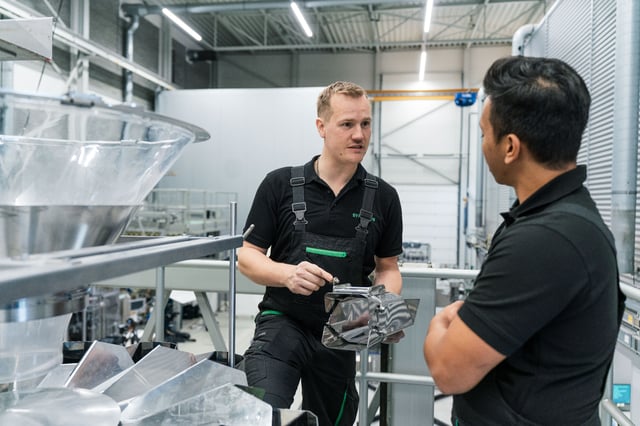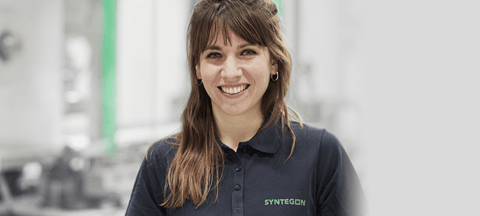
Service Agreements
Find out more about our Service Agreements here.


Syntegon offers a modular, turn-key solution for the “cold” membrane-based generation of pharmaceutical-grade pure water (PW), high purity water (HPW), and water for injection (WFI). Employing a full range of technologies including multi-layer filtration and ultrafiltration as well as physical-chemical processes including reverse osmosis and electrodeionization, our systems are configured to precisely address your individual requirements. Storage can be either hot or cold. Our approach substantially reduces the associated footprint, energy consumption, investment costs, qualification expenses, and ongoing maintenance costs when compared to traditional distillation-based systems.
Syntegon’s membrane-based pure media systems are robust, proven modular solutions that can be easily and quickly configured to meet your specific requirements. All modules are pre-tested and readily available. With a nominal production range of 200 to 20,000 liters per hour, the skidded systems are suitable for clinical and commercial manufacturing facilities alike.

Syntegon uses the highly energy-efficient “cold” membrane process of reverse osmosis, along with electrodeionization and ultrafiltration, in a modular, full-featured design. Storage can still be either hot or cold. This approach substantially reduces the initial capital investment, required footprint, energy consumption, as well as the ongoing qualification and maintenance costs when compared to traditional distillation-based systems.

Featuring a small footprint and height in all configurations for easy drop-in installation, the modular design is highly hygienic and accessible, making maintenance quick and easy. Measuring devices and sensors throughout ensure that the filter and water quality are monitored and maintained during the entire production process.
Water for injection (WFI) is an essential utility in pharmaceutical manufacturing that has traditionally been generated through the energy-intensive process of distillation. The recent revision of monograph 0169 of the European Pharmacopoeia, however – which has aligned the EP with the US and Japanese Pharmacopoeias in allowing suitable techniques other than distillation for the generation of WFI – has now made highly energy-efficient membrane-based systems a universally accepted alternative.
Our “cold” membrane-based systems employ a full range of unit operations including multi-layer filtration and ultrafiltration as well as physio-chemical processes including reverse osmosis and electrodeionization to precisely address our customers’ individual requirements. Our systems are capable of continuous production during partial sanitization with hot water and can also be sanitized chemically. Storage can be either hot or cold, based on your specific applications. Measuring devices and sensors throughout ensure that the unit operations and water quality are monitored and maintained during the entire production process.
A precise analysis of your requirements ensures that the right amount of water is available at all points of consumption without any loss of quality. Particular attention is paid to monitoring and hygiene during cold or hot storage. Pure water tanks with modular distribution skids are available for cold storage and distribution of PW or WFI. Ozone can be added to protect against microbial contamination. During production, a UV system in the supply system of the ring line ensures that the dissolved ozone is depleted. During hot storage, WFI is continuously recirculated. Cold taps are provided via sub-loops with integrated cooling modules.
Turning to hot storage to avoid treatment with ozone no longer means bigger, more expensive, and energy-hungry generation systems. Hot WFI storage and distribution is now a standard option for our membrane-based “cold” WFI generation systems. This innovative approach is enabling customers preferring or requiring hot WFI storage to realize significant savings in both CAPEX and OPEX. The smaller footprint makes it a convenient, affordable drop-in option for existing facility upgrades and new facilities alike. What’s more, the energy savings from reduced or altogether eliminated cold water and heating steam consumption make it a highly sustainable solution.
Tailored modular pretreatment systems for both raw and potable water
Membrane-based, energy-efficient GMP generation of PW and HPW with a small footprint and excellent accessibility
Membrane-based, highly energy-efficient GMP system for the “cold” generation of WFI with ultrafiltration for the final reduction of endotoxins
Comprehensive storage and distribution systems for PW and WFI with continuous monitoring of all quality-relevant attributes
Distribution loops with recirculation lines with point-of-use management and sanitization

| Pretreatment | PW and HPW | WFI |
Storage and Distribution |
|
|
Output* (l/h) |
up to 20,000 | 200-20,000 | 300-13,000 | up to 38,500 |
|
Options |
|
|
|
|
We offer the right pretreatment, generation, and storage and distribution solutions for every water quality. Larger and intermediate sizes are also available upon request, as well as a wide range of other modular options that can be integrated into customer-specific systems.
*standard configure-to-order systems; custom solutions with higher output are also available

Find out more about our Service Agreements here.

Find out more about Digital Solutions here.

Find out more about Parts here.

Find out more about Maintenance here.
/remote-assistant.jpg?width=640&height=640&name=remote-assistant.jpg)
Find out more about Technical Support here.

Find out more about Modernizations here.

Find out more about our Training here.

Find out more about our Expert Services here.

The Syntegon subsidiary Pharmatec has been supplying pure media systems to the global pharmaceutical industry for 30 years. All over the world, our solutions provide everything required for a seamlessly integrated system infrastructure – from hot and cold generators to storage and distribution systems; from pre-configured units to highly customized solutions. Regardless of the application, our systems provide a seamless process from generation to distribution at the point of use, including the associated CIP systems.
Join us at Pharmatag 2025 in Crailsheim, Germany, and experience how co-creation revolutionizes tomorrow’s pharmaceutical processes.
Stay informed about the booming RTU syringe market and Syntegon's AIM DIRect, featuring...
Discover the TPR tablet compression range from Syntegon, a trusted name in OSD drug manufacturing...
Join us at Pack Expo in Chicago from November 3-6! Discover Syntegon's solutions in the Healthcare...
Meet our experts at CPHI in Milan from October 8 to 10, 2024. Learn more about Syntegon's...
WFI has traditionally been generated through the energy-intensive process of distillation, but the recent revision to monograph 0169 of the European Pharmacopoeia (EP) has now also made techniques other than distillation universally accepted. The revision has finally aligned the EP with the US and Japanese Pharmacopoeias in allowing more energy efficient alternatives. Syntegon acted on this regulatory change right as it took place and was among the first industry suppliers to introduce the new type of generation unit for WFI in Europe. Our MWFI system uses the “cold” membrane process of reverse osmosis, along with electrodeionization and ultrafiltration, in a modular, full-featured design. Storage can be either hot or cold.
In essence, the unit must produce water under tightly monitored conditions that eliminate impurities and prevent the growth of microorganisms. Regular sanitization of the unit using hot water or chemicals prevents the formation of biofilms. Syntegon’s systems offer both options. Monitoring all the processes in the production chain (in particular the integrity of the membranes) is essential to guaranteeing the microbial quality of the water, which is why Syntegon outfits its systems with a variety of sensors and measuring devices. We monitor total organic carbon (TOC), conductivity, and other important parameters of water quality throughout. An online microbe counter is also available as an option.
The operating cost differential depends primarily on the consumption level and the efficiency of the correspondingly sized thermal generation system (i.e. the number of distillation columns in the system). On the low end, for pilot and small-scale facilities with an annual consumption of around 5 million liters per year, typical savings are in the order of ~30%. On the high end, for large facilities with 40 million liters or more of annual consumption, savings can easily reach ~40%. These are typical savings that factor in maintenance and materials in addition to the utilities consumption. We invite you to get in touch for a tailored assessment of the savings potential in your particular facility.
Ozone as a treatment agent remains somewhat problematic to handle and difficult to measure accurately in solution. And since turning to hot storage (to avoid ozone treatment) no longer means bigger, more expensive, and energy-hungry generation systems, hot storage is a fully financially viable solution for many customers. With the hot WFI storage option now standard for the MWFI, customers need not compromise. But Syntegon offers comprehensive hot and cold storage and distribution options alike. The specific use case determines which storage type is the better option for each customer.